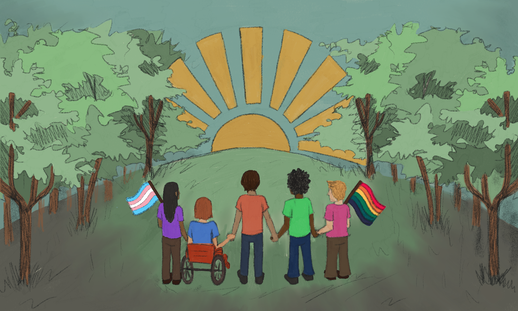Anita Rao (she/her)Who belongs in the outdoors? To some, a traditional outdoorsman may come to mind. He is physically fit, conquering nature with every fishing trip and embodying peak masculinity as he connects with the Earth. He may be clad in flannel, camo, or a fur hat, but probably all of the above. Philosophies of man and solitude, pushing yourself to your physical limits, and going off the beaten trail surround him. This archetypal outdoorsmen clearly does not encompass everyone who appreciates nature. Furthermore, a physically taxing and isolated outdoor experience may not be safe or possible for many people. Still, outdoor recreation has long excluded those who are not wealthy, white, and able-bodied men from reaping all the benefits nature has to offer.  Art by Olivia Spicer Art by Olivia Spicer Statistics collected by the U.S. Forest Service, National Park Service, and Fish and Wildlife Service show that although people of color make up nearly 40 percent of the U.S. population, close to 70 percent of people who visit national forests, national wildlife refuges, and national parks are white. Black people especially remain the most dramatically underrepresented group in these spaces. It’s also no secret that the expensive outdoor recreation industry has ensured hobbies like skiing or rock climbing are outside of many consumers’ price ranges. Compounded by the historic lack of green spaces in poorer neighborhoods, appreciating the natural world too often comes with a hefty price tag. Ableism is also rampant in these circles. The dominant culture places honoring the physical endurance of peaking mountains or traversing trails over basic accessibility accommodations. While the obvious answer may be that everyone belongs in natural spaces, there is clearly work required to reach this reality. Where do LGBTQ+ people fit into the conversation? Spending time in nature can bring people feelings of great freedom and peace. For some, however, those same experiences can be incredibly fearful. Everyone faces standard physical and safety risks like injury, wildlife encounters, or getting lost. Typically, with proper planning and awareness these dangers are known and accepted as part of the experience. LGBTQ+ people face their own additional challenges, from unaccepting communities to genuinely dangerous locations. National parks, hidden-gem lookouts, and remote trails can spell trouble for LGBTQ+ folk fearing discrimination and danger from locals or other visitors. Like many marginalized groups, LGBTQ+ nature-lovers cannot afford to just seek out stunning scenery, but must keep in mind the political climates they may be placing themselves in. Some of the best bird-watching, star-gazing, or even field research appropriate locations are remote and thus neighbored by hostile political climates. The possibility of getting stranded in a location where anything from uneasy looks to hate crimes could occur may turn some LGBTQ+ people away from seeking out these experiences entirely. Where it concerns scientific research and field opportunities, as long as discrimination in rural or natural areas persists, LGBTQ+ professionals find themsleves at a systemic career disadvantage. When sleeping under the stars with a group of strangers, or even relying on each other in potentially life-threatening situations, you can’t afford to question if you are truly accepted. Part of the outdoorsy culture involves a romanticization of bonding with strangers; it is beautiful to think that the world is your oyster and that a found family on camping grounds or hiking trails can be amazing company. While this may be true, LGBTQ+ people often don’t feel represented or even assured of their security in these group settings. Some may offer the solution of conforming to fit in safely with the cisgender and heteronormative subset of the outdoor community. Certain people may unfortunately feel the need to do so to feel safe, but ultimately having to change the way we present our gender, relationships, or identity in any way is never an ideal solution. Fortunately, there are efforts that exist to remedy this dilemma. Online you can find LGBTQ+ safe travel guides, queer outdoor safety tips, and even local nature groups made up of allies and community members. As someone most familiar with bird watching, I can share that one great (and cleverly named) organization is the “Let’s Go Birding Together” Audubon group. LGBTQ+ people can certainly conquer every natural challenge and find home in any outdoor environment, but it can be a comfort to know that such resources exist nonetheless. When I’m out bird watching on a beautiful day, I’m looking to find Ruddy Ducks and American Woodcocks, not trouble with homophobic onlookers. I want to appreciate the solitude of the Arb on a cool morning without worrying about self-defense as a woman alone in the woods. I want to watch mallards bob down Huron River without second guessing my outfit choice for the excursion. I hope to one day partake in field research without questioning my safety or belonging in the scientific world. Beyond this, I’d love to someday see my race, gender, and sexuality fully represented in the outdoor communities I belong to. Everyone’s hopes and fears in the outdoors are different: from the nonbinary rockclimber or the pansexual forager to the transgender ecological researcher. At the end of the day, we all unequivocally deserve to find peace and safety in the natural world. Whether we are climbing mountains, collecting specimens, or seeking owls, the LGBTQ+ community needs the space to exist in nature freely and fearlessly. Perhaps every time someone chooses to authentically express themselves in the outdoors, we draw a step closer to actualizing that dream for everyone. With safety, support, and allyship in mind, today is a beautiful day to venture outside.
0 Comments
Leave a Reply. |
Search by typing & pressing enter
